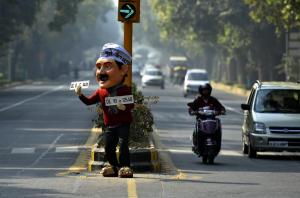Delhites, like me, have hailed the odd-even car experiment on its roads. But Prashant Kumar (a senior lecturer in wind engineering in University of Surrey), expresses his grave doubts to The Conversation. With due credit, we bring his nuanced opinion to readers as well as policy-makers of the Indian capital.
The city’s alternate-day car ban, where vehicles with odd-numbered plates are only allowed to drive on odd dates and vice versa, is intended to keep 20% of cars off the roads.. After exemptions for women drivers, VIPs, emergency vehicles, disabled drivers and so on, this is equivalent to about 6% of Delhi’s total vehicles.
Reports are thus far divided on its effectiveness. Some point to increased pollution levels on January 1 compared with December 31 while others show a marginal decrease.
But expectations may be too high. Even in the best case scenario the concentration of polluting particles in the city’s air would only be halved. “Only”? Well Delhi needs a staggering 39-fold reduction to meet the WHO’s safety limits.
Some of the confusion over whether “pollution” levels increased, decreased or remained unchanged is because reports aren’t clear about whether they refer to large or small particulate matter.
This car ban may help cut emissions of the smallest particles because combustion of fuel in vehicles produces these directly. However, it’s highly unlikely that it will help with the larger particles (“PM10”), which come more from tyre wear and road dust flung back into the atmosphere, and less from tailpipe emissions. The 6000 extra compressed natural gas busses introduced during this period to compensate for the banned cars easily will offset the road dust and tyre wear gains.
(So curb your enthusiasm, folks. And for god’s sake Arvind Kejriwal stop gushing “Delhi has done it.”)
The Indian capital has the dubious accolade of being regularly-cited as the most polluted city in the world, with air pollution causing thousands of excess deaths each year. While it might be easy to blame this on increased vehicle use, dirty industries or a growing population, the truth is that Delhi is a toxic pollutant punchbowl with lots of different ingredients.
Delhi’s landscape, weather, energy, consumption culture, and growing urban population combines to elevate concentrations of air pollutants, more so the harmful ultra-fine particles.
Coastal cities such as Mumbai have at least a chance to “replace” smog with relatively unpolluted sea breezes, whereas there are limited avenues for flushing away polluted air in landlocked Delhi. In fact, the regions surrounding the capital are sometimes even more polluted than the city itself. Most of Delhi’s brick kilns, for example, are actually found in upwind areas surrounding the city.
Pollution from outside the city itself is down to the use of raw wood, agricultural or plastic waste as industrial fuel, the use of cow dung for cooking stoves and the widespread use of diesel generators due to unreliable infrastructure.
The city’s “breath-ability” is further inhibited by dense built-up areas. This is exacerbated by emissions from late evening and overnight traffic which tends to linger at ground level due to the much cooler air above it.
Pollution intensifies during winter when farmers burn off husks from paddy fields upwind of Delhi. The very light wind speed and colder winter season leads to stable atmospheric conditions that let pollution hang around at “breathing” height.
And what to say of the rickety trucks, around 4 percent of city’s total vehicles, which belch out black exhaust smoke that contribute to as much as 65 per cent of total particle number emissions from all vehicles?)
Delhi’s pollution problem won’t be seriously addressed until ultra-clean electric public transport becomes the norm and, more importantly, the city’s metro system is substantially expanded.
For now, however, people must be protected in whatever ways they can be. Simple remedies such as “greening” unpaved roadside areas through a natural or artificial grass canopy could possibly help in limiting coarse dust particles during dry and windy seasons. Natural measures, such as the development of wetlands and trees are also effective.
There is also a cultural context here. Even the best science and technology won’t reduce emissions and improve air quality by themselves. India must figure out how new developments fit into the country’s economic development, while raising awareness of public health risks and changing attitudes towards and regulation of poor quality fuels. It is a complicated, pick-and-mix set of problems that will prove difficult to combat without innovative, encompassing and quick action.


